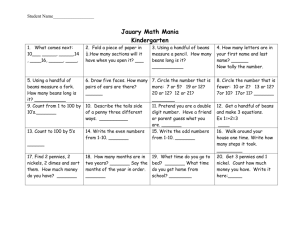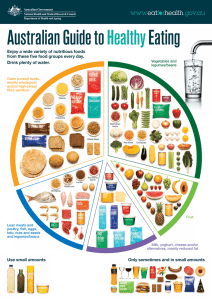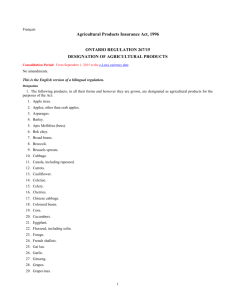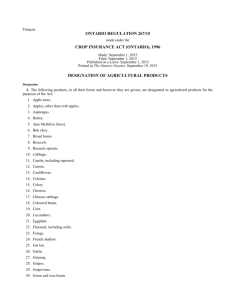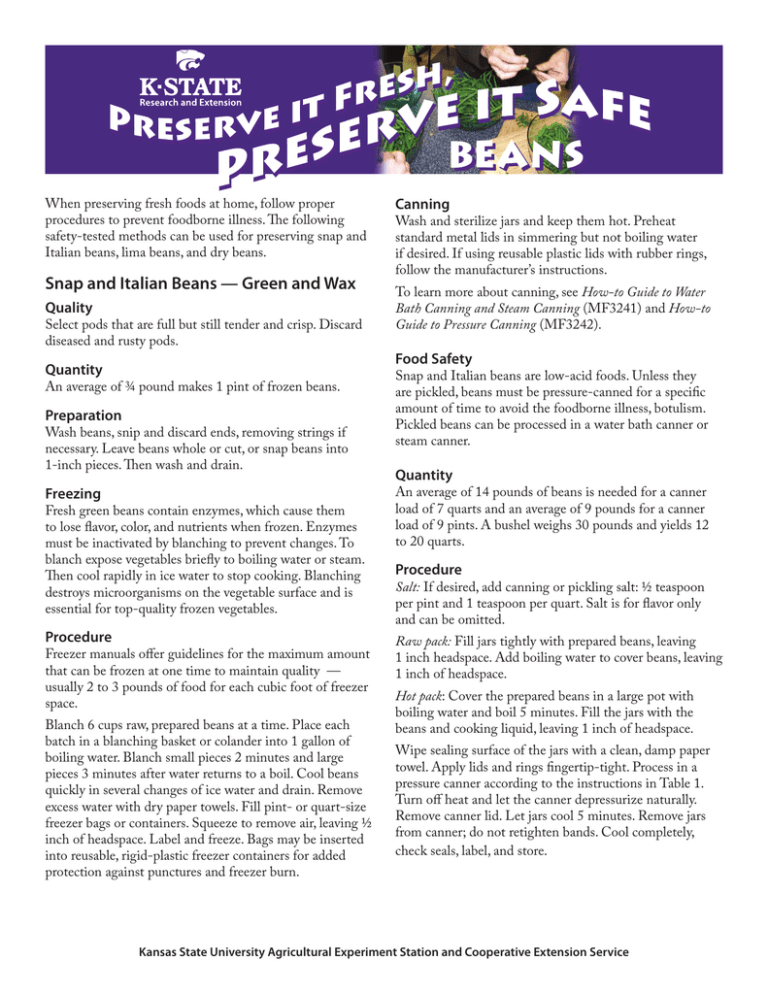
BEANS
When preserving fresh foods at home, follow proper
procedures to prevent foodborne illness. The following
safety-tested methods can be used for preserving snap and
Italian beans, lima beans, and dry beans.
Snap and Italian Beans — Green and Wax
Quality
Select pods that are full but still tender and crisp. Discard
diseased and rusty pods.
Quantity
An average of 3⁄4 pound makes 1 pint of frozen beans.
Preparation
Wash beans, snip and discard ends, removing strings if
necessary. Leave beans whole or cut, or snap beans into
1-inch pieces. Then wash and drain.
Freezing
Fresh green beans contain enzymes, which cause them
to lose flavor, color, and nutrients when frozen. Enzymes
must be inactivated by blanching to prevent changes. To
blanch expose vegetables briefly to boiling water or steam.
Then cool rapidly in ice water to stop cooking. Blanching
destroys microorganisms on the vegetable surface and is
essential for top-quality frozen vegetables.
Procedure
Freezer manuals offer guidelines for the maximum amount
that can be frozen at one time to maintain quality —
usually 2 to 3 pounds of food for each cubic foot of freezer
space.
Blanch 6 cups raw, prepared beans at a time. Place each
batch in a blanching basket or colander into 1 gallon of
boiling water. Blanch small pieces 2 minutes and large
pieces 3 minutes after water returns to a boil. Cool beans
quickly in several changes of ice water and drain. Remove
excess water with dry paper towels. Fill pint- or quart-size
freezer bags or containers. Squeeze to remove air, leaving 1⁄2
inch of headspace. Label and freeze. Bags may be inserted
into reusable, rigid-plastic freezer containers for added
protection against punctures and freezer burn.
Canning
Wash and sterilize jars and keep them hot. Preheat
standard metal lids in simmering but not boiling water
if desired. If using reusable plastic lids with rubber rings,
follow the manufacturer’s instructions.
To learn more about canning, see How-to Guide to Water
Bath Canning and Steam Canning (MF3241) and How-to
Guide to Pressure Canning (MF3242).
Food Safety
Snap and Italian beans are low-acid foods. Unless they
are pickled, beans must be pressure-canned for a specific
amount of time to avoid the foodborne illness, botulism.
Pickled beans can be processed in a water bath canner or
steam canner.
Quantity
An average of 14 pounds of beans is needed for a canner
load of 7 quarts and an average of 9 pounds for a canner
load of 9 pints. A bushel weighs 30 pounds and yields 12
to 20 quarts.
Procedure
Salt: If desired, add canning or pickling salt: 1⁄2 teaspoon
per pint and 1 teaspoon per quart. Salt is for flavor only
and can be omitted.
Raw pack: Fill jars tightly with prepared beans, leaving
1 inch headspace. Add boiling water to cover beans, leaving
1 inch of headspace.
Hot pack: Cover the prepared beans in a large pot with
boiling water and boil 5 minutes. Fill the jars with the
beans and cooking liquid, leaving 1 inch of headspace.
Wipe sealing surface of the jars with a clean, damp paper
towel. Apply lids and rings fingertip-tight. Process in a
pressure canner according to the instructions in Table 1.
Turn off heat and let the canner depressurize naturally.
Remove canner lid. Let jars cool 5 minutes. Remove jars
from canner; do not retighten bands. Cool completely,
check seals, label, and store.
Kansas State University Agricultural Experiment Station and Cooperative Extension Service
Pickled Three-Bean Salad
Yield: about 3 pints or 6 half-pints
1½ cups cut and blanched green or yellow beans
(prepared as below)
1½ cups canned, drained, red kidney beans
1 cup canned, drained garbanzo beans
½ cup peeled and thinly sliced onion (about 1 medium
onion)
½ cup trimmed and thinly sliced celery (1½ medium
stalks)
½ cup sliced green peppers (½ medium pepper)
½ cup white vinegar (5 percent)
¼ cup bottled lemon juice
¾ cup sugar
¼ cup oil
½ teaspoon canning or pickling salt
1¼ cups water
Wash and remove ends from fresh beans. Snap or cut
into 1- to 2-inch pieces. Blanch 3 minutes and cool
immediately. Rinse kidney beans with tap water and drain
again. Prepare and measure other vegetables. Combine
vinegar, lemon juice, sugar, and water and bring to a boil.
Remove from heat. Add oil and salt, and mix well. Add
beans, onions, celery, and green pepper to solution and
bring to a simmer. Marinate 12 to 14 hours in refrigerator,
then bring the entire mixture to a boil. Fill clean jars with
solids. Add hot liquid, leaving ½ of inch headspace. Apply
lids and rings fingertip-tight. Process in a water bath or
steam canner for 15 minutes at altitude 0 to 1,000 feet; or
20 minutes at altitude 1,001 to 6,000 feet. Turn off heat.
Remove canner lid. Let jars cool 5 minutes. Remove jars
from canner; do not retighten bands. Cool completely,
check seals, label, and store.
Beans, Shelled and Dried, All Varieties
Quantity
An average of 5 pounds is needed for a 7-quart canner
load, 3¼ pounds for a 9-pint load — ¾ pound per quart.
Quality
Select mature, dry seeds. Sort and discard discolored seeds.
Procedure
Place dried beans or peas in a large pot and cover with
water. Soak 12 to 18 hours in a cool place. Drain water. To
hydrate beans quickly, cover sorted and washed beans with
boiling water in a saucepan. Boil 2 minutes, remove from
heat, soak 1 hour, and drain. Cover with fresh water and
boil 30 minutes. Add ½ teaspoon of salt per pint or
1 teaspoon per quart to the jar, if desired. Fill jars with
beans or peas and cooking water, leaving 1 inch of
headspace.Apply lids and rings fingertip-tight. Process in
a pressure canner following recommendations in Table 1.
Turn off heat and let the canner depressurize naturally.
Remove canner lid. Let jars cool 5 minutes. Remove jars
from canner; do not retighten bands. Cool completely,
check seals, label, and store.
Beans, Baked
Quantity
An average of 5 pounds of beans is needed for a 7-quart
canner load and 3¼ pounds for a 9-pint load — about
¾-pound per quart.
Quality
Select mature, dry seeds. Sort and discard discolored and
damaged seeds.
Procedure
Sort and wash dry beans. Add 3 cups water for each cup of
dried beans. Boil 2 minutes. Remove from heat, soak for
1 hour, and drain. Heat to boiling in fresh water and save
liquid for making sauce.
Molasses sauce – Mix 4 cups water or cooking liquid from
beans, 3 tablespoons dark molasses, 1 tablespoon vinegar,
2 teaspoons salt, and ¾ teaspoon powdered dry mustard.
Heat to boiling.
Place seven ¾-inch pieces of pork, ham, or bacon in an
earthenware crock, a large casserole, or pan. Add beans and
enough molasses sauce to cover beans. Cover and bake 4 to
5 hours at 350°F. Add water as needed — about every hour.
Fill jars, leaving 1 inch of headspace. Apply lids and
rings fingertip-tight. Process in a pressure canner as
recommended in Table 1. Turn heat off and let the canner
depressurize naturally. Remove the canner lid. Cool jars for
5 minutes, and then remove from canner. Do not retighten
bands. Cool completely, check seals, label, and store.
Dry Beans with Tomato or Molasses Sauce
Quantity
An average of 5 pounds of beans is needed for a 7-quart
canner load and 3¼ pounds for a 9-pint load — about
¾-pound per quart.
Quality
Select mature, dry beans. Discard any that are discolored or
damaged.
Procedure
Sort and wash dry beans. Add 3 cups of water for each cup
of dried beans. Boil 2 minutes and remove from heat. Soak
1 hour, and then drain. Heat to boiling in fresh water. Save
liquid for making one of the following sauces:
Tomato sauce – Mix 1 quart tomato juice, 3 tablespoons
sugar, 2 teaspoons salt, 1 tablespoon chopped onion, and
¼ teaspoon each of ground cloves, allspice, mace, and
cayenne pepper. Heat to boiling.
1½ cups chopped onion
1 cup chopped peppers of your choice (optional)
1 teaspoon black pepper
3 to 6 tablespoons chili powder
2 quarts crushed or whole tomatoes
Ketchup sauce – Mix 1 cup tomato ketchup with 3 cups
cooking liquid from beans. Heat to boiling.
Molasses sauce – Mix 4 cups water or cooking liquid from
beans, 3 tablespoons dark molasses, 1 tablespoon vinegar,
2 teaspoons salt, and ¾ teaspoon powdered dry mustard.
Heat to boiling.
Wash beans thoroughly and place in a 2-quart saucepan.
Add cold water to cover by 2 to 3 inches. Soak 12 to 18
hours. Drain and discard water. Combine beans with 5½
cups of fresh water and 2 teaspoons salt. Bring to a boil.
Reduce heat; simmer 30 minutes. Drain and discard water.
Fill jars three-fourths full with hot beans. Add a ¾-inch
cube of pork, ham, or bacon to each jar, if desired. Fill jars
with heated sauce, leaving 1 inch of headspace.
In a skillet, brown ground beef, chopped onions, and
peppers if desired. Drain fat and add 3 teaspoons salt,
pepper, chili powder, tomatoes, and drained, cooked beans.
Simmer 5 minutes. Do not thicken.
Apply lids and rings fingertip-tight. Process in a pressure
canner as recommended in Table 1. Turn off heat and let
the canner depressurize naturally. Remove canner lid. Cool
jars 5 minutes. Remove from canner. Do not retighten
bands. Cool completely, check seals, label, and store.
Fill jars, leaving 1 inch headspace. Wipe rims with a
damp, clean paper towel. Apply lids and rings fingertiptight. Process in a pressure canner according to the
recommendations in Table 1. Turn off heat and let the
canner depressurize naturally. Remove canner lid. Let jars
cool 5 minutes. Remove jars from canner. Do not retighten
bands. Cool completely, check seals, label, and store.
Beans, Fresh Lima – Shelled
Quantity
An average of 28 pounds is needed for a 7-quart canner
load, 18 pounds for a 9-pint load. A bushel weighs 32
pounds and yields 6 to 10 quarts — an average of 4 pounds
per quart.
Problems and Solutions
1. Can plain green beans be processed in a waterbath canner?
Quality
Select well-filled pods with green seeds. Discard insectdamaged and diseased seeds.
No. Beans are a low-acid vegetable and must be
processed in a pressure canner. Improper processing of
beans or other low-acid vegetables can result in growth
of Clostridium botulinum, which causes the foodborne
illness botulism. Pickled beans are the only beans that
can be processed safely in a water-bath canner.
Procedure
Shell beans and wash thoroughly.
Hot pack – Cover beans with boiling water and heat to boil.
Fill jars loosely, leaving 1 inch of headspace.
Raw pack – Fill jars with raw beans. Do not press or shake.
2. Can salt be left out when canning beans?
Large beans – leave 1 inch headspace for pints, 1¼ inches
for quarts.
3. Can beans be added to home canned salsa
before canning?
Yes. Salt is for flavor and can be left out to reduce
sodium content.
Small beans – leave 1 inch of headspace for pints, 1½ inches
for quarts.
Add 1 teaspoon of salt per quart, if desired. Add boiling
water, leaving headspace as described above. Apply lids and
rings fingertip-tight. Process in a pressure canner according
to the recommendations in Table 1. Turn heat off and let
the canner depressurize naturally. Remove canner lid. Cool
jars 5 minutes, then remove from canner; do not retighten
bands. Cool completely, check seals, label, and store.
No. Adding beans changes the acid content of the salsa
and makes it unsafe when canned. Add beans when
ready to serve the salsa.
4. What causes cut ends and seeds inside of green
beans to turn reddish-brown?
Faint red pigments (anthocyanins) are present in small
amounts in some varieties of green beans. Pigments may
appear brown when canned but are safe to eat when
processed properly. Another possible cause is overly
mature beans.
Chili Con Carne
Yield: 9 pints
3 cups dried pinto or red kidney beans
5½ cups water
5 teaspoons salt (separated)
3 pounds ground beef
3
Table 1. Recommended processing times for pressure-canning beans
Canner gauge pressure for different altitudes (in feet)
Dial gauge (lbs.)
Snap and Italian Beans, Wax and
Green
Style of Pack
Jar Size
Hot and Raw
Pints
Quarts
Pints
Quarts
Pints
Quarts
Pints
Quarts
Pints
Quarts
Pints
Beans – Shelled, Dried: All Varieties Hot
Beans, Baked
Hot
Beans, Dry, with Tomato or
Molasses Sauce
Hot
Beans, Fresh Lima
Hot and Raw
Chile Con Carne
Hot
Process Time (min.) 0-2,001
20
25
75
90
65
75
65
75
40
50
75
Weighted gauge (lbs.)
2,001-4,000 0-1,000
11
11
11
11
11
11
11
11
11
11
11
12
12
12
12
12
12
12
12
12
12
12
Above 1,000
10
10
10
10
10
10
10
10
10
10
10
15
15
15
15
15
15
15
15
15
15
15
Nutritional analysis
Green or Wax
Beans
Nutrient
(½ cup)
Calories
22.0
Carbohydrate (g) 4.9
Fat (g)
0.18
Protein (g)
2.36
Dietary Fiber (g) 2.0
Potassium (mg) 91
Sodium (mg)
With salt
149
Without salt
1.0
Pickled Three
Bean Salad
(½ cup)
140.0
21.0
5.0
3.0
3.0
141.6
Beans –
Shelled, Dried
(½ cup)*
122.0
22.4
0.56
7.7
7.7
373
Baked Beans
(½ cup)
200.0
35.0
1.5
13.0
11.0
601.8
Dry Beans
with Tomato
Sauce
(½ cup)
190.0
37.0
1.0
12.0
11.0
657.7
170.0
NA
203.0
1.0
420
NA
270
NA
Lima Beans
(½ cup)
105.0
20.1
0.27
5.8
4.5
484.0
Chili con
Carne
(1 cup)**
290
30.0
8.0
24.0
7.0
1041.5
215.0
14.0
910.0
260.0
*based on Pinto Beans
**based on 90% lean ground beef
Karen Blakeslee, M.S., Extension Associate, Food Science
Adapted from original by Karen P. Penner, Ph.D., and Jeanne Dray, April 1995
Complete Guide to Home Canning, USDA AIB No. 539, 2009; and So Easy to Preserve, 6th ed., The University of Georgia Cooperative Extension Service.
Some information provided by Jarden Home Brands, makers of Ball Brand Fresh Preserving Products. ©2014 Hearthmark, LLC dba Jarden Home Brands. All Rights Reserved.
Distributed by Hearthmark, LLC dba Jarden Home Brands, Daleville, IN 47334. Hearthmark, LLC is a subsidiary of Jarden Corporation (NYSE: JAH).
Brand names appearing in this publication are for product identification purposes only. No endorsement is intended, nor is criticism implied of similar products not mentioned.
Publications from Kansas State University are available at www.ksre.ksu.edu
Publications are reviewed or revised annually by appropriate faculty to reflect current research and practice. Date shown is that of publication or last revision. Contents of this
publication may be freely reproduced for educational purposes. All other rights reserved. In each case, credit
Karen Blakeslee, et al., Preserve it Fresh, Preserve it Safe Beans, Kansas State University, December 2015.
Kansas State University Agricultural Experiment Station and Cooperative Extension Service
MF1179 — December 2015
K-State Research and Extension is an equal opportunity provider and employer. Issued in furtherance of Cooperative Extension Work, Acts of May 8 and June 30, 1914,
as amended. Kansas State University, County Extension Councils, Extension Districts, and United States Department of Agriculture Cooperating, John. D. Floros, Director.


